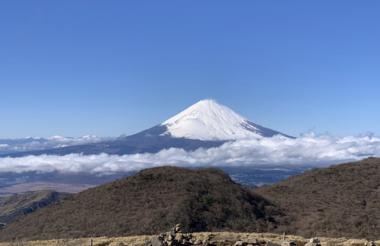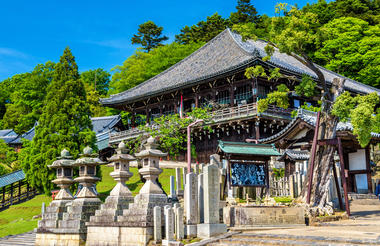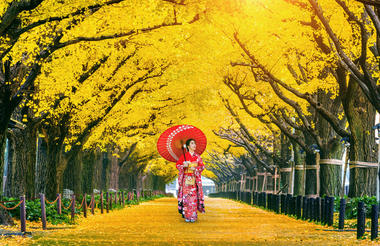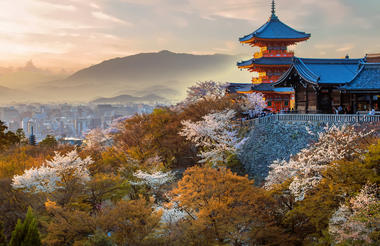FLY AUCKLAND TO TOKYO
Fly from Auckland to Tokyo Narita direct with Air New Zealand. (Other flight options are available - just ask us).
On arrival, you will be met and transferred to your hotel by private car.



Alongside your Japan Rail Pass, a Suica or PASMO travel card is the other essential thing you will need in Tokyo. It's a rechargeable smart card which will allow you to travel on Tokyo's Metro lines.
- Economy Class Airfare.
- All Airline taxes.
- Check-in Baggage Allowance.
- Arrival Transfer by Private Car.
- Overnight Accommodation.
- Tokyo accommodation Tax (approx NZ$2-4 per person per night payable locally).
TOKYO - FULL DAY TOUR
Enjoy an efficient, one-day tour of Tokyo accompanied by an English-speaking government-licensed guide. Your guide will introduce both modern and traditional aspects of Japan's dynamic capital.
Due to the enormous size of Tokyo, one of the largest metropolitan areas in the world, a one-day tour is best focused on one or two areas.
Tokyo is where you can experience both modern and traditional, and your experienced private guide will help you efficiently enjoy a full day in this dynamic Japanese capital.
Let us know what you would like to experience, and we will customise a six-hour tour that's best for you!



Please select your must-see spots from a list in the tour information to create your customised itinerary.
You will be able to design your tour by choosing 3-4 spots to focus on from the below.
- Asakusa
- Imperial Palace
- Shinjuku Gyoen National Garden
- Shibuya Crossing (Pass by)
- Tsukiji Fish Market
- Meiji Jingu Shrine
- Akihabara
- Koishikawa Korakuen Garden
- Hama Rikyu Gardens
- Tokyo National Museum
- Tokyo Skytree
- Senso-ji Temple
- Edo-Tokyo Museum
- Rikugien Garden
- Yoyogi Park
- Takeshita Street
- Roppongi Hills, Shop & Restaurant
- Odaiba District
- Shibamata
- Tokyo DisneySea
- Takaosan Yakuo-in Yuki-ji Temple
- Nezu
- Shinjuku Golden Gai
- Breakfast.
- Full Day Tour.
- English Speaking Guide for 6 hours
- Overnight Accommodation.
- Tokyo accommodation Tax (approx NZ$2-4 per person per night payable locally).
- All entrance fees and public transportation fees as mentioned in the itinerary
TOKYO - DAY AT LEISURE
Enjoy the day at leisure in Tokyo.






- Breakfast.
- Overnight Accommodation.
- Tokyo accommodation Tax (approx NZ$2-4 per person per night payable locally).
TRAVEL TO HAKONE
Today you will need to make your own way the short distance to Shinjuku Station in order to catch the Romance Car directly to Hakone-Yumoto Station.
Armed with your Hakone Free Pass you will be able to travel by Funicular Railway, Cable Car, Bus and even by Pirate Ship to explore this beautiful area of hot springs, pine clad hills and lakes in the shadow of Mount Fuji.



We have included a Romance Car upgrade for your journey to Hakone today. The Romance Car offers panoramic windows, in seat service and a faster service to Hakone than the regular train.
On arrival at Hakone-Yumoto we suggest you set off to explore the Hakone region first, rather than going to the hotel to check-in. Japan has a superb luggage forwarding service which can be used to forward your bags onward to your next destination. This can be organised directly with your hotel.
We highly recommend doing this in conjunction with your Japan Rail Pass as Japanese Railways Stations are often large and busy, so having only hand carry bags with you will make your journeys so much easier.
If you're active and like a good walk, you could take the Ropeway, cross the lake on the Pirate Ship (yes, there's a pirate ship!), and then make your way back on foot to Hakone-Yumoto.
It's a beautiful walk, but you'll need to be fit and ready to walk for 4 hours, although it's almost all either flat or downhill.
Some of the route goes along the ancient Tokaido Trail, including passing alongside some magnificent cedars.
- 14-day Japan Rail Pass.
- Romance Car from Shinjuku (Tokyo) to Hakone.
- 2-day Hakone Free Pass.
- Dinner in Hakone.
- Overnight Accommodation.
HAKONE - TAKAYAMA
Make your way by Hakone Tozan Bus to Gora Station and board the train at Hakone Yumoto to Odawara at around 10 am. At Odawara change to the Bullet Train to Nagoya where you will change on to the Hida Wide View Train, which has wide panoramic windows offering scenic views as you head into the Japanese Alps.
You'll be in Takayama around 3 pm. On arrival in Takayama make your own way to your hotel.
Takayama is a picturesque city situated in the Japanese Alps. The town prides itself on the inhabitant’s expertise in carpentry. The history of Tatayama is preserved in a number of small museums dotted throughout the city.
This afternoon you can visit the historic district of San-machi Suji, known for its sake breweries indicated by huge cedar balls hanging on the outside of shops.
If you like a walk, don’t miss the Higashiyama Walking Course through a forest and past temples and cemeteries.
This is a pleasant walking route through Takayama's temple town (Teramachi), the city's rural "suburbs" and Shiroyama Park, a wooded hill and former site of Takayama Castle.
Along the 3.5 km trail, you will pass more than a dozen common temples and shrines, the ruins of Takayama's former castle and ordinary scenes of a rural Japanese town.
While the Higashiyama Walking Course is by no means a stunning sightseeing experience, it offers a pleasant way to spend one or two hours and get to know Takayama's calmer side.



- Breakfast.
- 2-day Hakone Free Pass.
- 7-day Japan Rail Pass.
- Overnight Accommodation.
TAKAYAMA - DAY AT LEISURE
Enjoy the day at leisure to explore Takayama.
Takayama is a charming Japanese mountain town with bags of charm, lots of things to see and do and somewhere easily explored on foot. It's a great contrast to the hustle and bustle of Tokyo. It's also a wonderful place to try out Alpine cuisine, including Hida Beef.
You could start your day with a visit to Hida-Takayama Miyagawa Morning Market, open daily between 7 am and noon and one of the biggest morning markets in Japan. It takes place at two locations: One is held in front of the Takayama Jinya, and the other at the Miyagawa River side.
Sanmachi Suji is a historical area in Takayama's centre, consisting of three streets lined with traditional buildings and shops. The area was first developed in the Edo Period (17th-19th centuries) as a merchant district and is now home to many historic buildings, including sake breweries, temples, and shrines. This is the focus of town and a great place to wander. Pop into Kusakabe Heritage House in this district.
Also in the centre of town is The Takayama Showa Museum, an interesting little museum which recreates life in Japan during the 1950's. It's definitely worth a stop here.
Situated in Takayama's old town next to the Sakurayama Hachiman Shrine and about a 25-minute walk from Takayama Station, The Takayama Festival Float Exhibition Hall is home to 11 of the floats which are used during the spring and autumn Takayama Festivals.
The Hida no Sato Folk Village is a museum exhibiting about 30 traditional farmhouses which reflect the architectural styles of the mountainous regions of Japan.
The houses were built during the Edo Period (1603-1868) and were relocated from their original locations to create the museum in 1971. It's located about 2 km from the station in the South West of town.
Takayama's Teramachi is a heritage district in Takayama, in the Higashiyama walking area, on the outskirts of downtown. It's a great place to explore if you want some easy hiking and to see temples and shrines.
This historically rich area is home to 13 temples and five shrines, which visitors can explore via walking paths, all within minutes walk of each other. None are large, but they are all very well kept and contain many historic buildings.






- Breakfast.
- 7-day Japan Rail Pass.
- Overnight Accommodation.
TRAVEL TO KANAZAWA
Make your own way to Takayama Station and travel by rail to Kanazawa.
On arrival at Kanazawa Station make your own way to your hotel. At the station, you can admire the huge wooden gate, which symbolizes a traditional Japanese instrument called a tsuzumi (hand drums).
Kanazawa is famous for its Samurai heritage. This afternoon you could walk in the footsteps of Samurai in the Nagamachi Samurai District. Here you'll find restored Samurai houses, be able to have a go at silk-dyeing (reservations required), visit the Maeda Tosanokami-ke Shiryokan Museum with its Samurai displays and explore Nomura Samurai House, which holds the remains of the highly ranked Nomura Samurai family.
Kanazawa's lively and colourful Omicho Market has been the largest fresh food market since the Edo Period, with about 200 shops and stalls.
Here you'll find local seafood and produce, flowers, clothing, kitchen tools and much more. It's a great place to people watch and browse the stalls as well as enjoying some of the best seafood in the country. There are plenty of great place for dinner here.



- 7-day Japan Rail Pass - Ordinary.
- Overnight Accommodation.
KANAZAWA - SELF-GUIDED EXCURSION
Enjoy the day at leisure exploring Kanazawa.
Kanazawa's Kenroku-en Garden is one of Japan's three most beautiful landscape gardens, featuring a variety of flowering trees which provide the garden with a different beauty each season.
The spacious grounds used to be the outer garden of Kanazawa Castle, constructed by the ruling Maeda family centuries ago. It's a place you can easily spend a couple of hours or more admiring the landscaped gardens where feudal lords have strolled over the centuries.
Seisonkaku Villa within the gardens, is one of the most elegant remaining Samurai villas in Kanazawa, built in 1863 as a retirement home for the mother of Maeda Nariyasu, the 13th daimyo of the Kaga Clan. Today, it is open for public viewing and features a collection of her personal belongings.
Kanazawa Castle Park adjoins the gardens and is a lovely place to enjoy the open space and stunningly reconstructed castle. From 1583 to the end of the Edo Period, Kanazawa Castle, was the seat of the powerful Maeda Clan. It burnt down several times over the centuries, most recently in 1881, where only two storehouses and the Ishikawa-mon Gate survived.
By the Castle Park is the Gyokusen Inmaru Garden, a reconstructed Edo-era garden where it's possible to enjoy a Tea Ceremony at Gyokusen-an Rest House. Be sure to visit Oyama Shrine here also, a rather unique monument.
Close to one of the garden entrances are a handful of small museums which are worthy of a look. You'll find the Ishikawa Prefectural Museum of History and Kaga Honda Museum, the Ishikawa Prefectural Museum of Art and the National Crafts Museum. If your interests extend to Zen Buddhism, the DT Suzuki Museum is a few minutes walk from here.
Also nearby is the 21st Century Museum of Contemporary Art which is highly recommended for it's unique interactive experiences.
Kanazawa has three preserved Geisha Districts, of which the Higashi Chaya District is the most prominent. Kanazawa Asanogawa Enyukai Hall, a renovated traditional townhouse, introduces local geisha culture with various exhibits.
Kaikaro is is the largest chaya in the Higashi Chaya District. It's a refurbished 200-year-old chaya house with vermilion-lacquered stairs, vegetable-dyed tatami mats, fusuma-e (paintings on sliding-door panels), and a Japanese tearoom with tatami made of gold-laced woven straw, all of which help reproduce the atmosphere of a historic chaya house.
Kazuemachi Chaya District is just across the bridge and offers a quiet riverside geisha area.
South of the Sai River is Nishi Chaya District, a well-preserved Edo-era Teahouse District. It consists of just one street but packs plenty of historic charm. The Nishi Chaya Museum is worth having a look at here.



Ask at the information centre at Kanazawa Castle for free tours of the castle and gardens, lasting about 30 minutes.
Kanazawa is famous for its Gold Leaf. You'll find gold leaf covered ice cream to try and sprinkles of gold dust in your miso soup!
- 7-day Japan Rail Pass - Ordinary.
- Overnight Accommodation.
TRAVEL TO KYOTO - EVENING TOUR
Make your own way to the station and use your Japan Rail Pass to travel by bullet train to Kyoto.
On arrival in Kyoto make your own way to the hotel and drop your bags at your hotel.
This afternoon you could take a stroll along the Philosopher's Path at the foot of the Higashiyama hills in Eastern Kyoto. You can being with a visit to Ginkaku-ji Temple and walk this lovely streamside path to Nanzen-ji at the southern end. It's not far from here to Gion.
This evening, make your own way to Gion for 6 pm and meet your guide in front of Gion Omoide Museum.
Experience one of the most popular walking tours in Kyoto, joined by nearly 5,000 guests annually. This 100-minute guided walk is led by a licensed English-speaking guide and takes you through nighttime Gion.
Walk down the classic cobblestoned streets next to the Shirakawa River, and admire the scenery that was featured in the book and film, Memoirs of a Geisha.
As you walk beside this beautiful stream, the guide will tell you about the history of geisha and give you a detailed explanation in regards to their kimono, hairstyle, traditional rules, and what their daily life is like.
Although it is not guaranteed, during the walking tour guests often encounter geisha walking along the street.



Kyoto is without doubt the highlight of any trip to Japan. It can be a little bit overwhelming with so much to see, and a bit of planning will go a long way to ensuring you see the best sights, don't spend time getting lost and don't get 'templed-out'.
- 7-day Japan Rail Pass.
- 100 minutes Guided Group Walking Tour.
- Overnight Accommodation.
- Kyoto accommodation Tax (approx NZ$3 per person per night payable locally).
KYOTO - FULL DAY EXCURSION
Enjoy an efficient, one-day tour accompanied by an English-speaking government-licensed guide. Your guide will introduce both modern and traditional aspects of Japan's cultural capital.
Today's time with your guide can be tailored to suit you, so the itinerary outlined here is just a suggested one and can be altered to fit your interests. We will put you in touch with your guide well in advance of travel so you can liaise with the guide directly by email.
Begin you day at Kiyomizu-dera Temple is a significant Buddhist temple in Eastern Kyoto and one of the highlights of Kyoto. Kiyomizudera is best known for its wooden stage that juts out from its main hall, 13 metres above the hillside. The stage affords nice views of the numerous cherry and maple trees below that erupt in a sea of colour in spring and fall, as well as of the city of Kyoto in the distance.
From Kiyomizu-Dera head to Yasaka Shrine, a famous shrine in Kyoto which was founded over 1350 years ago. Located between Gion District and Higashiyama District, the shrine is often visited by those walking between the two districts.
Long connected with the Kyoto Geisha community centered in the nearby Gion District, Yasaka-jinja Shrine is a bustling, colourful and pleasant downtown shrine that lies at the heart of much of Kyoto's festive tradition.
From here walk to Nijo Castle, a flatland castle in Kyoto built in 1603 as the residence of the Shogun Tokugawa Ieyasu. It's an unusual castle for Japan and is most famous for its Nightingale Floors.
From here, head to Sanjusangendo, the popular name for Rengeo-in, a temple in eastern Kyoto, famous for its 1001 statues of Kannon, the goddess of mercy, as well as for being the longest wooden structure in Japan. It was founded in 1164 and was rebuilt a 100 years later, after being burnt down.
Nishiki Market is a great spot explore for lunch.
This afternoon you could take a stroll along the Philosopher's Path at the foot of the Higashiyama hills in Eastern Kyoto. You can being with a visit to Ginkaku-ji Temple and walk this lovely streamside path to Nanzen-ji at the southern end.
It's not far from here to Gion which is a great place for dinner.



- Full Day Tour.
- English Speaking Guide for 6 hours.
- Overnight Accommodation.
- Kyoto accommodation Tax (approx $2-3 per person per night payable locally).
- All entrance fees and public transportation fees as mentioned in the itinerary.
NARA - SELF GUIDED EXCURSION
Today you could make a visit to nearby Nara. From Nara Kintentsu Station, on the way to Nara park, stands a famous mochi shop called Nakatanidou, where crowds of visitors flock to daily.
Nakatanidou's pride and claim to fame is their dramatic mochi-pounding process, a tradition known as mochitsuki in Japanese. They perform high-speed mochitsuki every day at the shop, churning out hundreds of pieces of mochi, fresh and warm from the pounding.
Kofukuji Temple is an easy five-minute walk from Kintetsu Nara Station.
During the Heian period, Kofukuji was the temple of the most powerful family in Japan, the Fujiwara's. It was established in Nara in 710, at the same time as the capital. If you pay to enter only one of the buildings here, make it the Kofukuji Kofukuji National Treasure Museum which contains many extremely valuable documents and treasures from Nara 's history as the capital of Japan.
From here you could take a stroll to pretty Yoshikien Garden, with a pond, moss garden and tea ceremony garden which is free to visit. Neighbouring Isuien Garden is als great, but there is a fee to enter.
Next up, head on to Todai-ji Temple which houses the Great Buddha statue designated as a national treasure, and the world's largest wooden structure.
For a great view over Nara, hike up the stairs to Nigatsudo. At Mount Wakakusa you can pay to enter an enclosed deer park if you wish.
Nara's grandest shrine houses four main deities and many lucky gods Kasuga Taisha is considered one of the most sacred sites in all of Japan. As a place where numerous gods are enshrined, it attracts both devotees and tourists seeking an iconic Shinto experience. It is famous for its beautifully lit bronze lanterns.
There is another area of Nara you may want to explore at Nishinokyo, to the West of Nara Park. This is home to Yakushi-ji Temple, a UNESCO World Heritage site and Horyuji Temple.






Miyakoji Rapid trains operate every 30 minutes between Kyoto Station and JR Nara Station. The one way trip takes 45 minutes and is covered by the Japan Rail Pass. The trains arrive at JR Nara Station however which is a bit further away (about 10 minutes on foot) from Nara Park.
Alternatively, twice-hourly Limited Express trains take about 35 minutes and cost 1280 yen for the one way trip from Kyoto Station to Kintetsu Nara Station. These Kintetsu Line Trains aren't included on the JR Pass so you will need to pay separately.
If you want to get to Nara on a special train check out the Aoniyoshi Train which needs a special ticket.
In the Deer Park you can buy Sanbei (crackers) to feed the deer. If you bow at the deer, you may find they bow back!
- Overnight Accommodation.
- Kyoto accommodation Tax (approx NZ$3 per person per night payable locally).
KYOTO - SELF-GUIDED EXCURSION
Enjoy the day at leisure to explore the Arashiyama district in the North West of Kyoto by the wide Katsura River.
This is an area home to the famous Arashiyama Bamboo Walkway.
Temples here include Tenryu-ji and Ryon-ji.
Cross the Togetsukyo Bridge and head up to Arashiyama Monkey Park Iwatayama for views over the area.
A visit to the hilltop Okochi Sanso Villa and Garden is also recommended here, especially if you want to get away from the crowds a little bit.
For a great scenic trip from Arashiyama, take the Sagano Romantic Train for 25 minutes through a lovely valley. Return to Arashiyama by normal train or by Hozugawa Riverboat.
Not too far away are the famous Kinkaku-ji Temple and Ryoanji Temple Rock Garden which you might want to combine with a visit to Arashiyama.






To get to Arashiyama you can take a train from Kyoto Station in about 30 minutes. Alternatively go by tram from Shiji-Omiya to Arashiyama. Randen Arashiyama Tram Station is worth a look as there are often performances going on in front of the entrance. There is also a foot-bath Onsen in the station.
For the best experience, get to Arashiyama Bamboo Grove early in the morning.
You can spend a morning in Arashiyama to see the bamboo walkway and temples, but if you do the Sagano Romantic Train and come back by boat, it's a full day.
It's best to take things slowly here, so ideally put aside a full day for this part of Kyoto.
Make sure you try Matcha Tea from one of the shops in Arashiyama. Kakuda Kouseien is a good shop to seek out. The main street of Arashiyama leading away from the bridge is busy but has great street food.
- Overnight Accommodation.
- Kyoto accommodation Tax (approx $2-3 per person per night payable locally).
FLY TO AUCKLAND
Spend the morning in Kyoto.
Make your own way to Kyoto Station and catch the bullet train to Shinagawa where you will connect on to the Narita Express to Narita Airport for your flight back to New Zealand.
Fly from Tokyo Narita to Auckland with Air New Zealand.



- Rail Tickets Kyoto - Tokyo Narita.
- Economy Class Flights.
- Airline Taxes.
- Check-in Baggage Allowance.
ARRIVE AUCKLAND
Arrive back in New Zealand.






